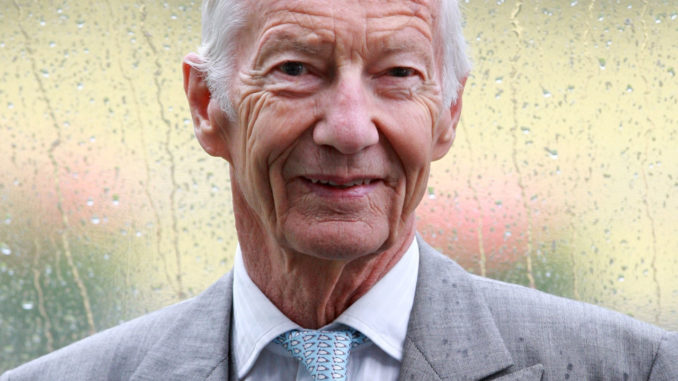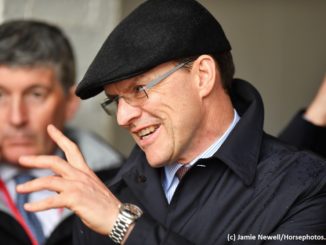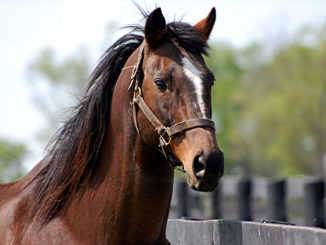
In our collaborative tribute to the late Lester Piggott, Vance Hanson highlights the great jockey’s forays to North America, and Kellie Reilly commemorates several of his brightest European stars.
The death of British riding great Lester Piggott on Sunday at age 86 is a loss on par with those of Bill Shoemaker and Eddie Arcaro, American riders who transcended their profession to become identifiable figures to both the general sports fan and the wider public in their home country.
Among active riders, Frankie Dettori is arguably the spiritual successor to Piggott in Britain. However, some commentators in Britain suggest that even Dettori’s immense popularity hasn’t quite equaled Piggott’s at its peak, perhaps a reflection of racing’s larger presence in the public’s consciousness during Piggott’s era.
Like his contemporary Shoemaker, Piggott’s transatlantic forays were relatively limited. Unlike today, when multi-million dollar events like the Breeders’ Cup are common and the ease of shipping and travel much improved, there were few enticements for Europeans to compete in the U.S. in Piggott’s time. One of the notable exceptions was the Washington D.C. International (G1) at Laurel, the racing world’s first truly global event that Piggott would win three times.
Piggott rode in the International five times from 1955 through 1967, always finishing out of the money aboard double-digit longshots. His mount in 1968, Sir Ivor, was cut from an entirely different cloth.
Trained by Vincent O’Brien and victorious that season in the 2000 Guineas, Epsom Derby, and Champion S., Sir Ivor started as the 19-10 favorite in the International. Extricating Sir Ivor from a pocket in upper stretch, Piggott drove the colt in between rivals and produced a devastating late kick to win from Czar Alexander and Fort Marcy, the latter a two-time International winner. Piggott over the years would say Sir Ivor was the best he ever rode.
Piggott was successful in the International again the following year aboard Karabas. Despite possessing lesser credentials than Sir Ivor, Karabas put America’s best in their place, prevailing over that season’s turf champion Hawaii and Czar Alexander.
Piggott didn’t win the International from four attempts in the 1970s, despite riding two highly capable performers. In 1970 he finished a distant fifth aboard Lorenzaccio, who was coming off an upset win in the Champion S. at Newmarket over the soon-to-be-retired Triple Crown winner Nijinsky. In 1974 Piggott was aboard the great mare Dahlia, with whom he had teamed up to win the Canadian International (G2) at Woodbine the race before.
Dahlia, who had won the 1973 International, was sent off as one of the heaviest favorites in International history at 3-5. But in a rare tactical lapse, Piggott completely misjudged the pace and underestimated the competition.
As recounted by jockey Ron Turcotte in a 2021 interview, Piggott allowed Dahlia to lag behind ridiculously slow fractions on firm ground. Still seven lengths behind after the first 10 furlongs were run in 2:06.40, Dahlia wound up third behind European outsider Admetus and the pace-setting, dual champion dirt filly Desert Vixen, the mount of Turcotte.
Piggott’s third and final International victory came in 1980 aboard the French colt Argument, whose only prior stakes win occurred in Belgium but had placed in the French 2000 Guineas (G1) and Prix de l’Arc de Triomphe (G1).
Piggott’s other U.S. successes prior to his first retirement in 1985 were limited to minor events at tracks like Bay Meadows, Hialeah, and Santa Anita. However, he produced a legendary encore shortly after his return to the saddle in October 1990.
Riding Royal Academy in the Breeders’ Cup Mile (G1) at Belmont Park for O’Brien, the then 54-year-old Piggott turned in a patented stretch ride aboard the 2.80-1 favorite, rallying to win by a neck from Itsallgreektome, who would go on to be named champion turf male.
Piggott’s European highlights
Royal Academy was the coda to a legendary Piggott-O’Brien partnership that had begun nearly a half-century before, with the outstanding staying mare Gladness. A late-developing type who reached the peak of her powers at five, Gladness first teamed up with Piggott in the 1958 Gold Cup at Royal Ascot.
O’Brien famously gave the rider an in-depth briefing, complete with race film, to familiarize him – in a meeting of two geniuses with a preternatural feel for their horses. Not only did Piggott steer her to victory on that occasion, but they added that summer’s Goodwood Cup and Ebor H. on cruise control.
Gladness was a “great galloper,” he told fellow jockey-turned-author Dick Francis for his biography of Piggott, A Jockey’s Life. One of Piggott’s record 11 Gold Cup winners, she is nowadays less well known than his stars from the late 1970s and early 1980s.
The sublime Sagaro made history as the first to three-peat in the Gold Cup (1975-77). Piggott hailed the Francois Boutin trainee as “a magnificent stayer, as good as any I rode, and his turn of foot was, for a long-distance performer, phenomenal” (from Ascot: The History, by Sean Magee with Sally Aird). Three more Gold Cups followed in rapid succession with Le Moss (1979) and the double by Ardross (1981-82).
Ardross was trained by Sir Henry Cecil, whose former father-in-law was the great horseman Sir Noel Murless. Piggott was Sir Noel’s stable jockey for about a decade from the mid-1950s to 1960s, and their prolific relationship furnished two of his all-time greatest mounts, Crepello and the filly Petite Etoile.
Both would contribute to his record haul of 30 British classic wins. Petite Etoile, arguably the best of his six Oaks heroines, ranked as Britain’s Horse of the Year in 1959 after defeating older males in the Sussex and Champion S. Prince Aly Khan’s homebred went on to land the 1960-61 runnings of the Coronation Cup.
“She had won nearly all of her races by one length or less, with Lester often thought to have left her winning run too late,” Francis observed. “She was a racer, however, who came always with late acceleration, and was not at her best if left too long in front. In Lester she had the perfect jockey, cool enough to wait, confident enough to set her flying just in time.”
Crepello’s brilliant acceleration propelled him to victory in the 2000 Guineas and Derby, where he beat O’Brien’s world-class *Ballymoss in 1957.
“I just went through them so easily, it was hard to believe,” Piggott told Francis of his Guineas display at Newmarket.
“Crepello worked very well before the Derby, as well as any horse I’ve ever seen. His gallops were terrific. He was one of the very best of horses.”
Thoughts of an English Triple Crown came to naught, unfortunately, as Crepello’s long-suspect tendon gave out on him when training for the St Leger. He never raced again, leaving a what-might-have-been since Piggott believed he would have been invincible going forward.
Piggott ultimately accomplished that historical rarity in 1970 with Nijinsky II. A full 35 years after Bahram last swept the 2000 Guineas, Derby, and St Leger, Nijinsky II etched his name on the honor roll.
By that very fact, you’d expect Piggott to rate him as the best he’d ever ridden. Yet the maestro gave the nod to another Guineas/Derby winner from Ballydoyle, the aforementioned Sir Ivor.
O’Brien, speaking to Francis in A Jockey’s Life, offered the likely rationale:
“I can imagine him saying that because there were no problems with Sir Ivor. He must have been a grand horse to ride, he was as tough as could be, he didn’t care, the crowd didn’t bother him a bit, the other horses being on their toes didn’t trouble him. During a race he didn’t pull, he’d settle and go anywhere you wanted, and where you asked him, he’d go, just like that. Whereas Nijinsky got tensed up and sweated. Once he was out of the stalls, Lester said, he was fine. He’d drop his bit and be perfectly all right, but the waiting about beforehand always upset him.”
Nijinsky II, Sir Ivor, and Crepello are among Piggott’s record nine Derby winners, a list that also encompasses Never Say Die (1954), when his rider was at the tender age of 18; St Paddy (1960); Roberto (1972), in perhaps his most desperate finish over Rheingold; Empery (1976); The Minstrel (1977); and Teenoso (1983). Nijinsky II, The Minstrel, and Teenoso (in 1984) likewise rank among his record seven wins in the King George VI & Queen Elizabeth (G1).
But Nijinsky II wasn’t able to give Piggott the Prix de l’Arc de Triomphe. Still feeling the effects of the about 1 3/4-mile St Leger that stretched his stamina, especially hard on the heels of a ringworm infection, the Ballydoyle great came up agonizingly short at ParisLongchamp. Ironically, Piggott earned his first Arc aboard a horse he was all-out to beat in the prior year’s Derby, Rheingold (1973).
Piggott won the Paris highlight twice more, courtesy of the O’Brien-trained Alleged (1977-78). Nearly perfect in his career, Alleged suffered his only loss in the St Leger, at the hands of The Queen’s Dunfermline.
Alleged was “one of the very easiest of horses to ride,” as Francis summed up Piggott’s view. “He would always do as he was asked, always give whatever he was capable of at any particular moment.”
The original master of Ballydoyle deserves the final word on Piggott.
“There’s no question he’s an absolute genius,” Vincent O’Brien told Francis. “I don’t believe there’s ever been a jockey who thinks more about what he’s ridden and what he’s going to ride.”



